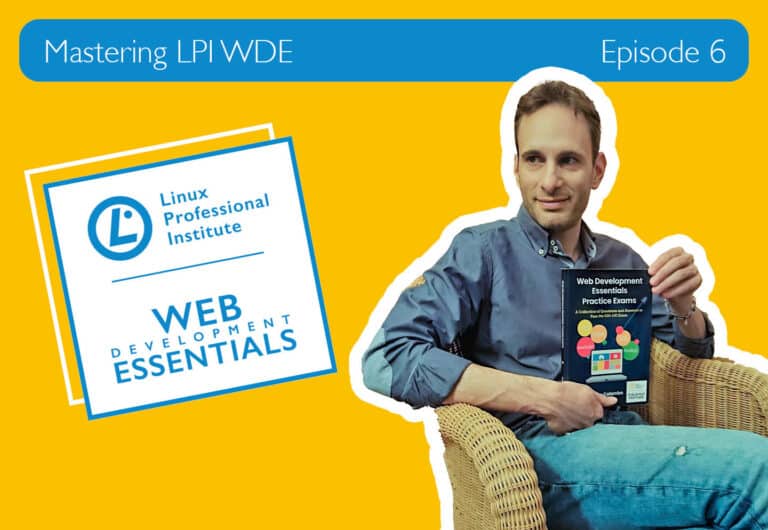Mastering LPI WDE: Materials, Practice, Simulations

In the previous articles of this series, we have examined the leading technologies covered by the Web Development Essentials certificate from Linux Professional Institute (LPI), both on the front-end side (such as HTML, CSS, and JavaScript) and on the back-end side (such as Node.js and SQL).
As we have seen, you can use HTML to structure your web pages semantically, CSS to apply styles and make them visually appealing, JavaScript to enable user interaction and add dynamism, Node.js to implement server-side logic, and SQL to query a relational database.
At this point, you may wonder, “How can I prepare for the WDE exam? Are there any reference materials? How can I simulate the exam?” This article will answer these and other questions.
How can I prepare for the LPI’s WDE certificate exam?
LPI’s Learning Materials are your initial reference point. The Linux Professional Institute (LPI) Learning Portal is the natural starting point for your learning journey and preparation for Linux and Open Source certification exams.
Each section of the Learning Materials has a well-delineated structure: a theory part and two sets of exercises with their solutions, following an approach oriented toward classroom use. These materials are continuously expanded and updated and are of great utility for both students and teachers.
Therefore, to prepare for the Web Development Essentials certificate, I recommend starting with the Learning Materials specifically written for that certificate.
You will find the exam objectives updated to the current version (exam code 030-100) and, for each Objective, one or more lessons depending on their scope and weight.
Each lesson, designed for one or two hours of frontal teaching, includes a theoretical part and a practical part where a student can immediately test the acquired knowledge in practice. Finally, the solutions to the proposed questions will allow you to check whether your exercises are correct and, in most cases, provide additional insights for further study.
The enormous potential of this educational material should be apparent: It is not only a free resource available to anyone who wants to delve into the world of programming but also a valid reference for those who, at the end of their studies, want to embark on the certification path itself.
Remember that, like all Learning Materials, those related to the Web Development Essentials certificate do not replace textbooks or practice and should complement other study sources.
And for practice?
Once you have learned the main exam topics from a theoretical perspective, it is necessary to practice–in fact, practice a lot… You can refine your skills and improve your web developer knowledge by practicing in the field. As discussed in the first post on HTML, you can start practicing by creating web pages using one of the text editors already on your computer, and then move on to slightly more sophisticated ones that I have suggested here or to a full-fledged IDE environment. Discovering all the features of these programs can be a professionally rewarding experience. You can improve your productivity by becoming a more efficient programmer during your learning journey.
Here are some other resources I recommend:
- Mozilla Developer Network: An accurate wiki available to all developers. It is ideal for beginners and, at the same time, an excellent tool for those who are already more experienced and want to improve their skills.
- Free Code Camp: A non-profit community that allows you to learn programming by completing real projects. You can learn to program through their learning platform, read publications, discuss questions on the technology forum, and much more.
Web Development Essentials Exam simulations
The Web Development Essentials certificate allows you to take the first steps in the web world. At the end of the path, you will need to take an exam that, like all essential certificates, consists of 40 questions over a period of 60 minutes.
To simulate the actual exam, I have published, as an LPI Publishing Partner, a resource called Web Development Essentials Practice Exams. It is a book of simulations that allows you to test your knowledge and skills before taking the exam.
The book contains four exam simulations and an entry test, totalling 170 questions and answers. Each question is accompanied by thorough comments to show the student the correct answer as well as the general context it refers to.
Some questions include code snippets you can reproduce in your text editor to find the correct answer. Furthermore, by trying to modify this code, you can create alternative scenarios that are useful for your learning.
Just the beginning
Remember that passing the exam does not make you an expert programmer. The exam is the starting point, not the destination.
Good developers must refine their knowledge daily and keep up with the times. You will need to learn new libraries, frameworks, and programming languages and, above all, put a lot of passion into it. This passion must be nurtured daily to improve yourself professionally.
Above all, you must love what you do because, as Confucius said:
Choose a job you love and you’ll never have to work a day in your life.
